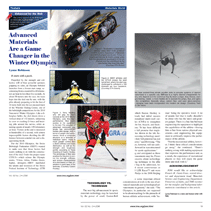 LATEST ISSUE |
||||
TMS QUICK LINKS: |
• TECHNICAL QUESTIONS • NEWS ROOM • ABOUT TMS • SITE MAP • CONTACT US |
JOM QUICK LINKS: |
• COVER GALLERY • CLASSIFIED ADS • SUBJECT INDEXES • AUTHORS KIT • ADVERTISE |
|
| Materials World: Feature | Vol. 62, No.2 pp. 17-19 |
Changer in the Winter Olympics
Lynne Robinson
Questions? Contact jom@tms.org. |
|
It starts with a push.
Like a fiberglass bullet, the sled shoots down a
vertical drop of 152 meters, subjecting
its crew to crushing G-force and bruising
jolts around the curves, while attaining
speeds of nearly 150 kilometers
an hour. Victory at the end is measured
in hundredths of a second, with almost
imperceptible factors deciding the difference
between a medal run and a disappointing
finish. THE SCIENCE OF THE SLED “An initial question we asked ourselves was ‘what slows down a bobsled?’” said Ulrich Suter, professor in ETH Zurich’s Department of Materials and CITIUS project coordinator. “After a careful analysis, we decided to break the problem into a number of simpler tasks. Aerodynamics is clearly important, especially in the very fast track at Whistler. The shape and surface structure of the runners are also very relevant. The hull and chassis materials, as well as the dynamics within the system, play a crucial role in the mechanical dissipation of energy in the bobsled. And, above all, safety is paramount— the sled must survive a crash at full speed and protect the crew. We numerically simulated all key aspects of the sleds and tried to isolate the most important factors, and then experimentally tested our assumptions to optimize the design.” A particular challenge for CITIUS was developing a state-of-the-art bobsled in accordance with the rules for construction and design enforced by the Fédération Internationale de Bobsleigh et de Tobogganing (FIBT), the governing organization for competitive bobsledding. The runners, for instance, have to be constructed from a rigidly defined steel procured from a prescribed source, with any type of modifying treatments “forbidden, including those which even cause only a local variation of the physical characteristics and/or of the composition and/or structure of the material.” Steels used elsewhere on the sled are more generally described as “an alloy of iron and carbon with an iron content of more than 50 percent,” while “rubber or rubber-like material” can be incorporated into the sled for the purpose of damping vibrations. Hulls have no prescribed material at all. Suter said he was surprised, actually, at “how many unspecified areas were left in a seemingly very complete—some might say overly complete—book of rules.”
Working within these parameters, a team of more than 20 ETH Zurich scientists and engineers from a wide range of disciplines applied their specific expertise to different aspects of the CITIUS bobsled. A battery of tests revealed the sources and nature of vibrations, which forces were exerted where on the chassis, and the specific stiffness and strength of certain materials. “Our
simulations indicated that several apparent
inefficiencies of the sleds might
be avoided with an appropriate choice
of materials,” said Suter. “However,
almost all standard elastomeric materials
were inadequate to the demands of
the sport. And, many tested adhesives
proved insufficient under the (dynamic)
mechanical and thermal stresses of
bobsled racing.”
The real moment of truth for the project occurred when, bristling with sensors to measure forces, driving dynamics, and aerodynamic properties, the CITIUS hurtled down an ice track for the first time near Innsbruck, Austria. Although highly guarded about revealing details of the CITIUS’ development and performance, the research team was pleased with the results, according to the CITIUS Dossier posted on the ETH Zurich Web site.
Whether smoothing the performance
of a bobsled careening down the Whistler
ice track, or giving an aerials skier
an extra bounce into the Canadian sky,
advanced materials technologies like
those used in the CITIUS project will
be on prominent display at this year’s
Winter Olympics. The quest for a competitive
edge through advancements in
engineering isn’t limited to these elite
athletes, however. Said Travis Downing,
a materials engineer in research and
development at Easton Hockey, California,
“Once full composite hockey
sticks were introduced onto the market
about ten years ago, they immediately
became the ‘must have’ stick among
professional players. Subsequently,
amateur players were quick to jump
on that trend, as well. The fact that it
is nearly impossible to find a wooden
hockey stick anymore speaks volumes
to the adoption rate of composite sticks”
(Figure 3).
“Perhaps the most interesting
thing about sports equipment is what
doesn’t drive change—cost,” Flores
continued. “Even recreational users
are willing to pay more for perceived
improvements in performance.”
Even with space age technology, the quest for optimum performance in sporting equipment can be challenging. “Because hockey is such a fast-paced sport with frequent collisions, it becomes crucial to have the proper balance of performance and durability in a stick,” said Downing. “The unfortunate reality is those factors are largely in opposition to one another, given the desire to maintain the lightest structure possible. Composite suppliers tend to address the problem by adjusting the epoxy formulation, with variation in fiber properties also factoring into the equation through alteration of tensile modulus, strength, and elongation to failure.”
The next big advancement in sports
materials technology may be launched
by the power of small. Easton-Bell Sports, of which Easton Hockey is
part, has already had initial success
adding functionalized multi-wall carbon
nanotubes (CNTs) to strengthen
epoxy resin for bat, bicycle, and hockey
applications. “It has been difficult
to realize the full promise that singlewall
CNTs has shown in the lab, because
the processing technology needed
to exploit their full potential has not
reached maturity,” said Downing. “The
next few years, however, will see additional
leaps forward in nanostructured
composites for sports applications.”
Lynne Robinson is a news and feature writer with TMS. |






